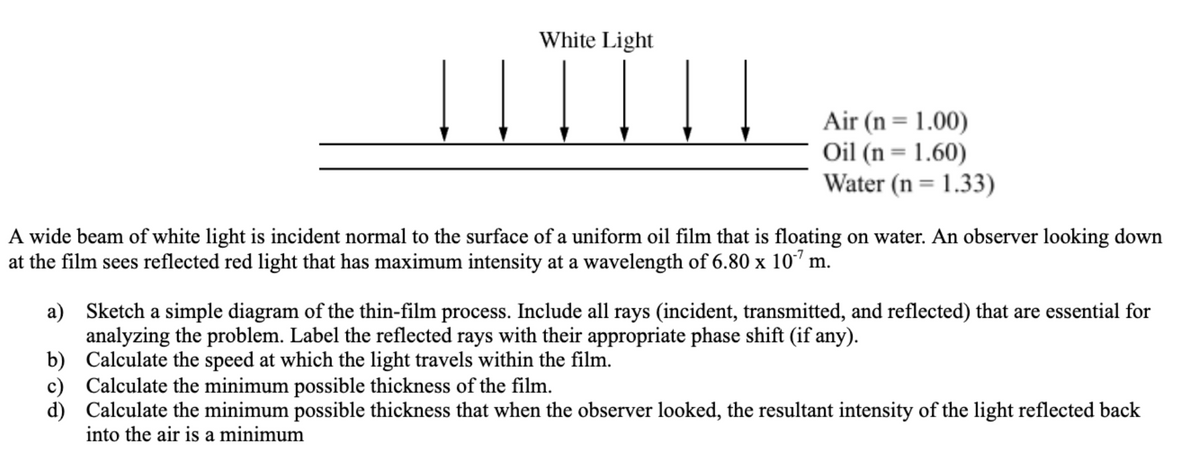A wide beam of white light is incident normal to the surface of a uniform oil film that is floating on water. An observer looking down at the film sees reflected red light that has maximum intensity at a wavelength of 6.80 x 10" m. a) Sketch a simple diagram of the thin-film process. Include all rays (incident, transmitted, and reflected) that are essential for analyzing the problem. Label the reflected rays with their appropriate phase shift (if any). b) Calculate the speed at which the light travels within the film. c) Calculate the minimum possible thickness of the film. d) Calculate the minimum possible thickness that when the observer looked, the resultant intensity of the light reflected back into the air is a minimum
A wide beam of white light is incident normal to the surface of a uniform oil film that is floating on water. An observer looking down at the film sees reflected red light that has maximum intensity at a wavelength of 6.80 x 10" m. a) Sketch a simple diagram of the thin-film process. Include all rays (incident, transmitted, and reflected) that are essential for analyzing the problem. Label the reflected rays with their appropriate phase shift (if any). b) Calculate the speed at which the light travels within the film. c) Calculate the minimum possible thickness of the film. d) Calculate the minimum possible thickness that when the observer looked, the resultant intensity of the light reflected back into the air is a minimum
Related questions
Question
How do you do this problem?

Transcribed Image Text:White Light
Air (n= 1.00)
Oil (n = 1.60)
Water (n = 1.33)
A wide beam of white light is incident normal to the surface of a uniform oil film that is floating on water. An observer looking down
at the film sees reflected red light that has maximum intensity at a wavelength of 6.80 x 10" m.
a) Sketch a simple diagram of the thin-film process. Include all rays (incident, transmitted, and reflected) that are essential for
analyzing the problem. Label the reflected rays with their appropriate phase shift (if any).
b) Calculate the speed at which the light travels within the film.
c) Calculate the minimum possible thickness of the film.
d) Calculate the minimum possible thickness that when the observer looked, the resultant intensity of the light reflected back
into the air is a minimum
Expert Solution
This question has been solved!
Explore an expertly crafted, step-by-step solution for a thorough understanding of key concepts.
This is a popular solution!
Trending now
This is a popular solution!
Step by step
Solved in 3 steps with 1 images
